|
Nissan Altima
Debut: 2007
Maker: Nissan
Predecessor: Altima (2001)
|
|
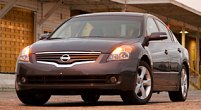 Nissan's
large front-wheel-drive platform FF-L gave birth to various vehicles
such as Teana, Altima and Maxima. While Teana targets at the domestic
market, Altima and Maxima are designed for the United States in
particular. The Altima is the cheapest one among them. It competes with
Toyota Camry and Honda Accord in the highest volume segment in the USA.
In 2005, a total of 255,371 Altimas found buyers there, taking the 5th
position in car sales chart. It is the company's best selling product
in America thus is very important to Nissan. Nissan's
large front-wheel-drive platform FF-L gave birth to various vehicles
such as Teana, Altima and Maxima. While Teana targets at the domestic
market, Altima and Maxima are designed for the United States in
particular. The Altima is the cheapest one among them. It competes with
Toyota Camry and Honda Accord in the highest volume segment in the USA.
In 2005, a total of 255,371 Altimas found buyers there, taking the 5th
position in car sales chart. It is the company's best selling product
in America thus is very important to Nissan.
 Since the
last generation arrived in 2001, Altima became driver-oriented. On the
one hand its stiff-tuned multi-link rear suspensions, large and
powerful 3.5-liter VQ-series engine and the availability of 6-speed
manual gearbox set it apart from the housewives-pleasing Camry and the
versatile Accord. On the other hand it was crude and unrefined, while
the cabin was cheaply built. Call it a "family muscle car". Since the
last generation arrived in 2001, Altima became driver-oriented. On the
one hand its stiff-tuned multi-link rear suspensions, large and
powerful 3.5-liter VQ-series engine and the availability of 6-speed
manual gearbox set it apart from the housewives-pleasing Camry and the
versatile Accord. On the other hand it was crude and unrefined, while
the cabin was cheaply built. Call it a "family muscle car".
The family muscle car has entered a
new phase in late 2006. Officially, it is an all-new generation, with
revamped exterior and interior, new engine and a new platform called
"D-platform". However, the D-platform is a mild update
rather than a fundamental change from FF-L, as is the exterior design
which looks like a facelift. Although most components have been
changed, the development cost is undoubtedly lower than a complete
redesign. By the way, Nissan adopted the same
strategy for its Skyline V36.
 Predictably,
the new Altima gets slightly more refined and better built. Its new
dashboard has richer textures and a few alloy-effect plastic panels to
make it look less cheap - but still
cheap compare with Toyota and Volkswagen. Its stiffer chassis and
revised suspensions (now with more aluminum parts) return better ride
quality - but still rests on the hard side. A similar story is found
for noise insulation, which has been improved slightly but still lags
behind key rivals. No one
will buy this car for quality and refinement. Predictably,
the new Altima gets slightly more refined and better built. Its new
dashboard has richer textures and a few alloy-effect plastic panels to
make it look less cheap - but still
cheap compare with Toyota and Volkswagen. Its stiffer chassis and
revised suspensions (now with more aluminum parts) return better ride
quality - but still rests on the hard side. A similar story is found
for noise insulation, which has been improved slightly but still lags
behind key rivals. No one
will buy this car for quality and refinement.
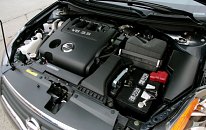 But they
may buy it for driving excitement. In fact, in the remake Nissan
focused even more on the driver appeal in order to depart from Camry
and Accord further. Firstly, the car is shortened by 44mm, accompany
with a reduction of 25mm in wheelbase to improve cornering agility.
Secondly, the new generation VQ35DE* engine produces 20 more
horsepower, or a total of 270hp, thanks to lower friction, twin-ram
intake, improved water cooling and knock control. This allows the big
family sedan accelerate from 0-60 mph in a class-leading 6.0 seconds
when mated with 6-speed manual gearbox. (Admittedly, most buyers would
opt for the Xtronic CVT, which adds a few tenths to 0-60 accompany with
a little rubber band effect. For keen drivers, manual is the first
choice of course.) Thirdly, the engine is now mounted 30mm lower in the
chassis to improve center of gravity. This also equalize the inclined
angles of left and right half shafts, thus greatly reduces torque
steer. You know, torque steer is always the enemy to powerful
front-wheel-drive cars, and it used to trouble the old Altima a lot. But they
may buy it for driving excitement. In fact, in the remake Nissan
focused even more on the driver appeal in order to depart from Camry
and Accord further. Firstly, the car is shortened by 44mm, accompany
with a reduction of 25mm in wheelbase to improve cornering agility.
Secondly, the new generation VQ35DE* engine produces 20 more
horsepower, or a total of 270hp, thanks to lower friction, twin-ram
intake, improved water cooling and knock control. This allows the big
family sedan accelerate from 0-60 mph in a class-leading 6.0 seconds
when mated with 6-speed manual gearbox. (Admittedly, most buyers would
opt for the Xtronic CVT, which adds a few tenths to 0-60 accompany with
a little rubber band effect. For keen drivers, manual is the first
choice of course.) Thirdly, the engine is now mounted 30mm lower in the
chassis to improve center of gravity. This also equalize the inclined
angles of left and right half shafts, thus greatly reduces torque
steer. You know, torque steer is always the enemy to powerful
front-wheel-drive cars, and it used to trouble the old Altima a lot.
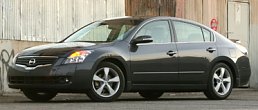 On the
road, the new Altima is fast and fun to drive. This is primarily due to
the strong engine and good steering. The speed-sensitive hydraulic
power steering returns good communication and linearity. It loads up at
speed to provide good confidence. Torque steer is largely non-existent,
while understeer intervenes gently when the car approaches limit. The
engine and steering are the Altima's trump cards. On the
road, the new Altima is fast and fun to drive. This is primarily due to
the strong engine and good steering. The speed-sensitive hydraulic
power steering returns good communication and linearity. It loads up at
speed to provide good confidence. Torque steer is largely non-existent,
while understeer intervenes gently when the car approaches limit. The
engine and steering are the Altima's trump cards.
Nevertheless, other aspects such as
body control, grip and brakes are only
average. Despite of the firm
ride, the car pitches and dives noticeably in hard acceleration and
braking, very much like old muscle cars. For poise and precision it
won't match Ford's CD3 cars (Mazda 6 and Ford Fusion) and Saturn Aura,
and I suspect the next generation Accord will leave it behind easily.
Nissan could have provided more rubber than the 215/55 and stronger
brakes. Also, ABS should have been standard in this class.
Unfortunately, it deliberately limited the car to lower the base price
and avoid competing with Maxima.
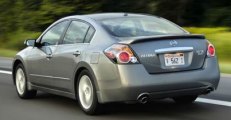 Disappointingly,
there are still a lot of rough edges in the Altima. For example, the
6-speed gearshift is clunky, and the clutch takeover is abrupt. Crude
and unrefined, the Altima is still very much a muscle car in its blood.
This
mean we cannot recommend Altima to keen drivers. When we turn our
attention to ride comfort, noise insulation and interior build quality,
the car loses even more marks. Yes, the new Altima is a step forward
from the old car, being more refined, more stylish, faster and better
to handle, as claimed by Nissan's officials. However, the step taken is
too small compare with its competitors. Just as its look suggests, it
is a
small evolution. Disappointingly,
there are still a lot of rough edges in the Altima. For example, the
6-speed gearshift is clunky, and the clutch takeover is abrupt. Crude
and unrefined, the Altima is still very much a muscle car in its blood.
This
mean we cannot recommend Altima to keen drivers. When we turn our
attention to ride comfort, noise insulation and interior build quality,
the car loses even more marks. Yes, the new Altima is a step forward
from the old car, being more refined, more stylish, faster and better
to handle, as claimed by Nissan's officials. However, the step taken is
too small compare with its competitors. Just as its look suggests, it
is a
small evolution.
* Unlike the VQ35HR
used in
Skyline / Infiniti G35, the cheaper VQ35DE employs variable valve
timing at intake valves only. |
| The
above report was last updated on 20 Jan
2007. All Rights Reserved. |
Altima Coupe
|
 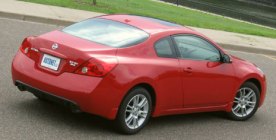
Just like Honda has Accord
Coupe
and Toyota has Camry Solara, Nissan also produces a coupe version of
Altima. The Altima Coupe is enclosed with a sleeker bodyshell and
shares
no panels with the sedan with the exception of the bonnet.
Underneath the sheet metal is much the same content, but the
wheelbase has been shortened by 100 mm and the overall length lost 185
mm as the coupe no longer needs to offer so much rear seat and luggage
room. This brings a weight advantage of 30 kilograms. However, the
shorter wheelbase and length also worsen its weight distribution – now
some 67 percent weight is loaded on the front wheels, hardly acceptable
for a driver's car. Besides, the engine remains unchanged from the
sedan, that means either a 175hp 2.5 four-banger or 270hp 3.5 V6.
Transmission is again that CVT or 6-speed manual. Of course, you don't
need to be reminded that the Altima Coupe is a front-wheel-drive car
with transversely mounted engine. All these seem to work against driver
appeal.
So how does it perform on the road ? As expected, performance from the
270hp VQ35DE is strong, perhaps too strong for the front-drive chassis.
As in the Altima sedan, if you push it too hard in corners, the power
can overwhelm the modest 215/55VR17 tires and torque steer is, while
not as severe as older generations front-drive performance cars,
far from negligible. Although the suspensions have been stiffened, the
unbalanced chassis pitches and dives under acceleration and braking.
Push it in the twisty and you can't find the planted feel of most
European coupes. A rubbery gearshift and little steering feel add to
the
disappointment. Don't be fooled by its sportscar appearance, the Altima
Coupe is very much a family sedan in coupe's shape. In fact, it cannot
match even a Volkswagen Golf GTI for handling.
Nor is it as comfortable or as roomy as Golf GTI. Any rear passenger
taller than 5 ft 8 in will find their heads rubbing against the roof,
blame
to the fastback design. Trading interior room for style is fully
understandable for coupes. The problem is, I don't think it really
beautiful. With high shoulder line, high bonnet and high trunk lid, the
coupe looks quite fat and bulky. Moreover, this Japanese design has
little character to talk about. I believe it will get outdated in a
couple of years' time, if not yesterday already.
There are two kinds of coupes in the market. One offers superior
performance and handling over sedans, for example, Audi TT and Infinti
G37. Another offers near sedan level of comfort and refinement in a
more beautiful package, such as Peugeot 407 Coupe and BMW 3-Series
Coupe. Altima Coupe belongs to neither of them. Call it a sports coupe
and it will disappoint keen drivers. Call it a comfort coupe and it
won't satisfy a family's requirements. Yes, it might be more likable
than Camry Solara and the outgoing Accord Coupe, but it is far from a
desirable choice. |
| The
above report was last updated on 23 Jun
2007. All Rights Reserved. |
|
|